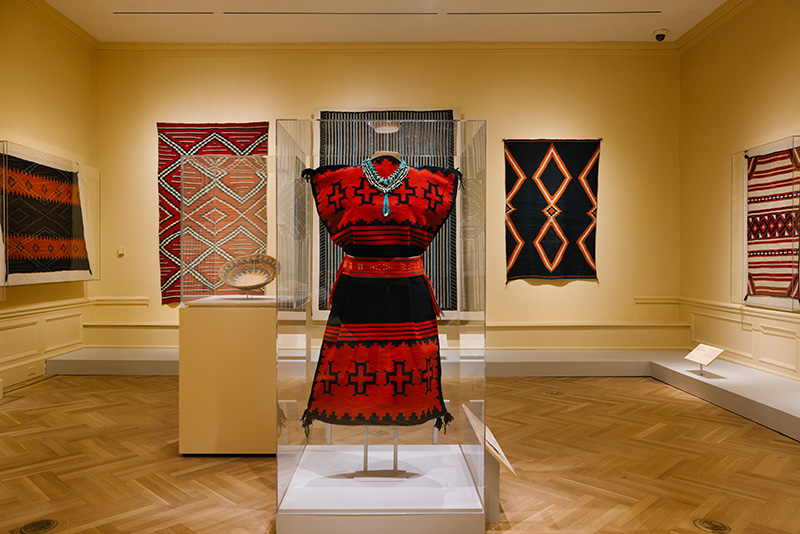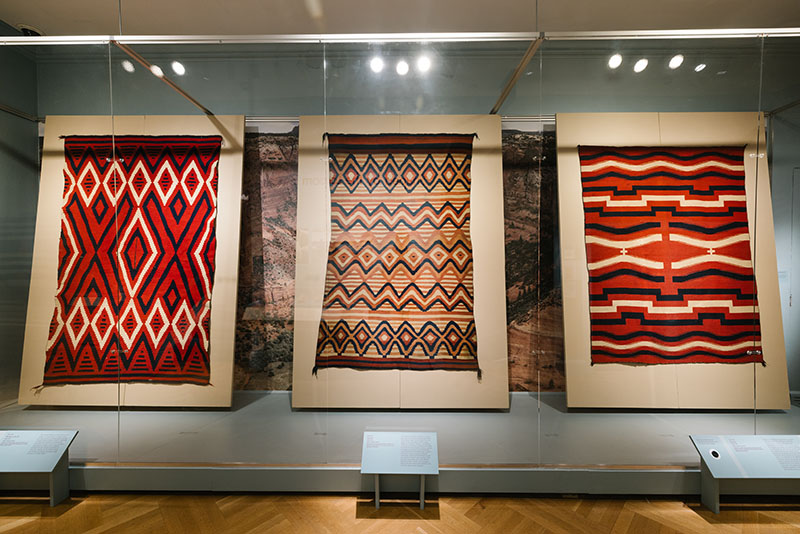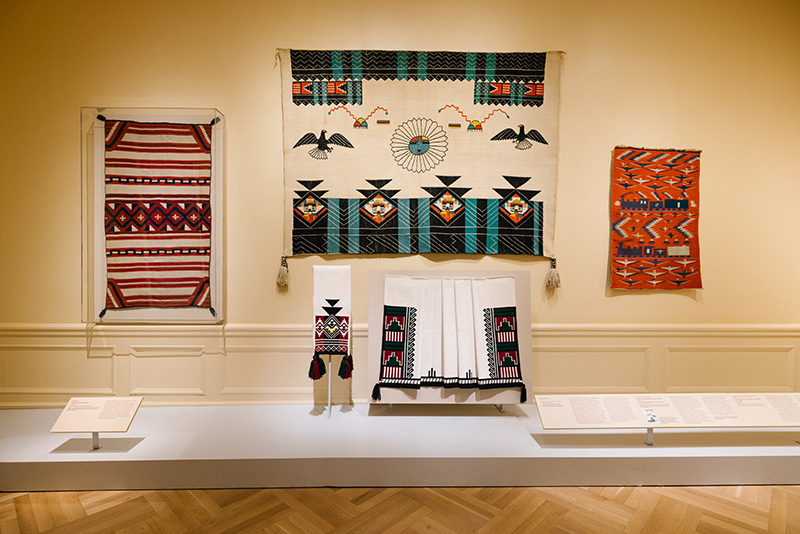Indigenous Imagination as Revolution: ‘Shaped by the Loom’ Opens at the Bard Graduate Center
by Juliana Fagua Arias
“When we sit at our loom, we sit at the universe.” Such were the words that 5th-generation Diné (Navajo) master weaver Lynda Teller Pete used to describe the profound significance of weaving and textiles in the North American Southwest. According to Navajo knowledge and cosmology, the upper and lower beams of the vertical loom symbolize the sky and earth respectively; the warp yarn represents male and female rain, while the interwoven horizontal weft yarns represent the earth’s sheep. The action of weaving therefore activates the universe’s natural cycles, the integration of counterparts. As the weaver warps the loom or slides the shuttle back and forth, they symbolically link day and night, sky and earth, male and female. Showcasing pieces by contemporary Diné artists alongside rarely exhibited historic Navajo textiles, Shaped by the Loom: Weaving Worlds in the American Southwest (figure 1), explores the materials, processes, traditions, and cosmologies that nurture Navajo weaving. Open at the Bard Graduate Center Gallery until July 9, 2023, the exhibit was curated by Hadley Jensen, BGC/AMNH Postdoctoral Fellow in Museum Anthropology, in consultation with Diné master weavers Lynda Teller Pete and Barbara Teller Ornelas. Shaped by the Loom focuses on Indigenous aesthetics and ways of knowing—from sheepherding, dye-plant collecting, and fiber making, to the stories and prayers that infuse the practice of creating textiles.
Foregrounding the active and historical practices that shape the art of weaving, the exhibition explores six themes: Homeland and Cosmology (figure 2), Ecology (figure 3), Dyeing and Coloring (figure 4), Techniques and Technologies, Design Elements, and Value and Exchange (figure 5). Complementing the vibrantly colored textiles with captivating geometric designs, the exhibition sheds light into some themes that are usually left out of the museum narrative on North American Southwest weaving, such as the Navajo weaving tools, which are usually made by men and passed down through a weaver’s family. The exhibition’s intention of tracing the material clues of processes in the weavings reflects Diné Bizaad’s (the Navajo language) emphasis on verbs as opposed to nouns, movements as opposed to things.
Figure 2. An immersive video by Rapheal Begay, with ambient sound by Connor Chee, shows panoramic imagery of culturally, cosmologically, and historically important locations in the Navajo homeland.
Figure 3. The exhibition explores the notion of Traditional Ecological Knowledge, a uniquely indigenous approach to understanding relationships between living beings—plants, humans, sheep—and their surrounding environment. The designs, fibers, and dyes that make up these weavings demonstrate the Diné artist’s expertise, individuality, imagination, and profound understanding of their landscape.
Figure 4. This Navajo dye chart by Roselyn Washburn (Diné) connects each colored yarn to a sample of the dried plant used to make its dye.
Figure 5. Installation view of a Hopi embroidered robe/manta (before 1910) attributed to an Ahbah (Hopi) craftsperson and of a contemporary Pueblo dance kilt and sash by textile artist Isabel Gonzales. The Hopi and Pueblo peoples have long established trade networks with the Navajo, which has resulted in an exchange of designs, materials, and techniques.
The spirited collaboration between curator Hadley Jensen and contemporary Diné weavers and artists such as digital artist and printmaker Darby Raymond-Overstreet (figure 6), visual storyteller and photographer Rapheal Begay (see figure 2), fiber artist and 6th-generation weaver Tyrrell Tapaha, and pianist and composer Connor Chee (see figure 2), transformed the usually static gallery into an interactive and immersive space of storytelling.
The exhibition’s use of digital tools and online components reflects the continued vibrancy of weaving traditions in Dinetah, the Navajo homeland. Complementing the physical gallery, the online exhibition acts as an interactive catalogue featuring about 250 items from the American Museum of Natural History’s collection of Navajo textiles as well as illustrated essays by renowned scholars, curators, and master weavers. Digital elements, including a 360-degree panoramic imaging of the cultural landscape of Dinetah, a magnification tool to look in detail at weave structures, dyes, and photo micrographs of fibers and raw materials, allow for a deep exploration of these interlaced elements.
Moreover, the exhibition opening comes with the release of Season 2 of the Fields of the Future podcast, which I had the pleasure to co-host with my colleague, weaver and educator Jessie Mordine Young. Throughout the season, we interviewed textile artists, scholars, and educators about the history, traditional ecological knowledge, and materiality and techniques of weaving in the North American Southwest and México, intentionally blurring established national boundaries. Interviews include conversations with award-winning Diné weaver Kevin Aspaas (figure 7) about the traditional Sheep-to-Loom process and the revival of Navajo wedge weave and with botanist and anthropologist Alejandro de Avila Blomberg, director of the Ethnobotanical Garden in Oaxaca, México.
Shaped by the Loom is a stunning homage to the generations of gifted Navajo weavers, past and present. It is a step forward in redressing the silent anonymity that tends to permeate exhibitions of Indigenous artworks where the makers fall into oblivion. The contemporary Diné artists that collaborated in the show ensured that it properly communicated teachings sowed from past generations connecting the artistry of weaving to living a well-balanced life. Indigenous imagination, which activates each of the artworks and objects in the exhibition, turns into revolution as asserted by photographer Rapheal Begay, a statement of the fact that Diné weavers will not be silenced anymore.
Juliana Fagua Arias is a PhD student in History of Art and Visual Studies at Cornell University.
About The Decorative Arts Trust Bulletin
Formerly known as the "blog,” the Bulletin features new research and scholarship, travelogues, book reviews, and museum and gallery exhibitions. The Bulletin complements The Magazine of the Decorative Arts Trust, our biannual members publication.
Click Images to Enlarge
Did you know that clicking on the images in Bulletin posts will allow you to get a closer look? Simply click on an image, and a larger version will open in a pop-up window.














